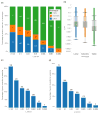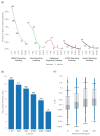Estimating the selective effects of heterozygous protein-truncating variants from human exome data
- PMID: 28369035
- PMCID: PMC5618255
- DOI: 10.1038/ng.3831
Estimating the selective effects of heterozygous protein-truncating variants from human exome data
Abstract
The evolutionary cost of gene loss is a central question in genetics and has been investigated in model organisms and human cell lines. In humans, tolerance of the loss of one or both functional copies of a gene is related to the gene's causal role in disease. However, estimates of the selection and dominance coefficients in humans have been elusive. Here we analyze exome sequence data from 60,706 individuals to make genome-wide estimates of selection against heterozygous loss of gene function. Using this distribution of selection coefficients for heterozygous protein-truncating variants (PTVs), we provide corresponding Bayesian estimates for individual genes. We find that genes under the strongest selection are enriched in embryonic lethal mouse knockouts, Mendelian disease-associated genes, and regulators of transcription. Screening by essentiality, we find a large set of genes under strong selection that are likely to have crucial functions but have not yet been thoroughly characterized.
Conflict of interest statement
The authors have no competing interests as defined by Springer Nature, or other interests that might be perceived to influence the results and/or discussion reported in this paper.
Figures






Comment in
-
Selective effects of heterozygous protein-truncating variants.Nat Genet. 2019 Jan;51(1):2. doi: 10.1038/s41588-018-0291-9. Nat Genet. 2019. PMID: 30478439 No abstract available.
Similar articles
-
Genome-wide Polygenic Burden of Rare Deleterious Variants in Sudden Unexpected Death in Epilepsy.EBioMedicine. 2015 Jul 10;2(9):1063-70. doi: 10.1016/j.ebiom.2015.07.005. eCollection 2015 Sep. EBioMedicine. 2015. PMID: 26501104 Free PMC article.
-
Inference of population mutation rate and detection of segregating sites from next-generation sequence data.Genetics. 2011 Oct;189(2):595-605. doi: 10.1534/genetics.111.130898. Epub 2011 Aug 11. Genetics. 2011. PMID: 21840859 Free PMC article.
-
The Characteristics of Heterozygous Protein Truncating Variants in the Human Genome.PLoS Comput Biol. 2015 Dec 7;11(12):e1004647. doi: 10.1371/journal.pcbi.1004647. eCollection 2015 Dec. PLoS Comput Biol. 2015. PMID: 26642228 Free PMC article.
-
Trying to understand the genetics of atopic dermatitis.Mol Cell Probes. 2016 Dec;30(6):374-385. doi: 10.1016/j.mcp.2016.10.004. Epub 2016 Oct 8. Mol Cell Probes. 2016. PMID: 27725295 Review.
-
What can exome sequencing do for you?J Med Genet. 2011 Sep;48(9):580-9. doi: 10.1136/jmedgenet-2011-100223. Epub 2011 Jul 5. J Med Genet. 2011. PMID: 21730106 Review.
Cited by
-
Unveiling recent and ongoing adaptive selection in human populations.PLoS Biol. 2024 Jan 18;22(1):e3002469. doi: 10.1371/journal.pbio.3002469. eCollection 2024 Jan. PLoS Biol. 2024. PMID: 38236800 Free PMC article.
-
Relating pathogenic loss-of-function mutations in humans to their evolutionary fitness costs.Elife. 2023 Jan 17;12:e83172. doi: 10.7554/eLife.83172. Elife. 2023. PMID: 36648429 Free PMC article.
-
Variant interpretation using population databases: Lessons from gnomAD.Hum Mutat. 2022 Aug;43(8):1012-1030. doi: 10.1002/humu.24309. Epub 2021 Dec 16. Hum Mutat. 2022. PMID: 34859531 Free PMC article. Review.
-
Distinct epigenomic patterns are associated with haploinsufficiency and predict risk genes of developmental disorders.Nat Commun. 2018 May 30;9(1):2138. doi: 10.1038/s41467-018-04552-7. Nat Commun. 2018. PMID: 29849042 Free PMC article.
-
Heightened condition-dependence of the sexual transcriptome as a function of genetic quality in Drosophila melanogaster head tissue.Proc Biol Sci. 2019 Jul 10;286(1906):20190819. doi: 10.1098/rspb.2019.0819. Epub 2019 Jul 10. Proc Biol Sci. 2019. PMID: 31288700 Free PMC article.
References
MeSH terms
Grants and funding
LinkOut - more resources
Full Text Sources
Other Literature Sources

